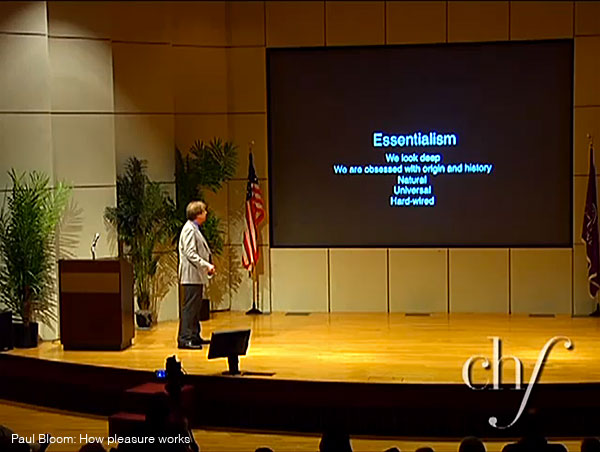Today I was able to watch Paul Bloom speech from Chicago Humanities Festival 2011, “How Pleasure Works”. What was interesting for me was that at one point he talks about psychological essentialism, saying:
“To some extent the social factors of status do affect how we perceive and value art, but what I want to try to convince you in this presentation is that there’s something else going on. Something that psychologists have called essentialism. And the idea of essentialism is that we don’t just focus on the superficial aspects of things, rather, we go deep. We are obsessed with origin and history. This is natural. Universal. Hard-wired and irresistible.”
— Paul Bloom
He does a lot of examples, spacing from art to sex and food as well, showing through these examples and researches how essentialism isn’t just a social and cultural construct, but exists in young children as well. Hard-wired indeed.
One of the examples he gives is an opera by Tom Friedman. The opera is a white piece of paper. It’s a completely blank canvas. The title is “A thousand hours of staring”, and the reason of it is that the artist stared at that blank sheet of paper for 1.000 hours.
I think that essentialism points out a very interesting aspect that can give us a good way to interpret art and to juxtapose it to design. It will not answer every possible question, it won’t close any debate, but I still found it very interesting.
Follow me for a moment.
Essentialism might be the reason why design is different from art, even when the two result in exactly the same thing from a pure perception standpoint. Now of course it’s very difficult to have a work of art and a work of design producing exactly the same visual result, the same architecture, the same music or performance, or else, but it’s not hard to imagine if you take the example of Tom Friedman above, or if you remind the saying “Oh, I could have done that”.
The difference lies in what’s behind that. While both design and art can create beautiful results, it’s the essence of it, it’s the story behind that distinguish the two. In simplistic terms it’s also the amount of time that the opera symbolizes. It’s the meaning of it that’s important. It’s the human nature that it connects with, the one of the author(s) connecting in some way with yours.
That’s why two drawings that look exactly the same will be different when someone tells you that one is by Picasso and the other by their friend. It’s because we attach meaning to these art creation that transcend the appearance itself. I probably shouldn’t use this term, but in some way it is its “soul”.
That’s why if I take anything from the road and I place it inside an empty room in a museum, everybody will start thinking “what is the author trying to tell me?”. It’s automatic, because we expect that from art. And I’m not fantasizing: Marcel Duchamp did exactly this with his “Fountain“, and it’s also probably one of the provocations behind Piero Manzoni’s “Artist’s Shit“.
Essentialism doesn’t apply to art only, but from its perspective anything can be art as long as there’s a story attached to it with probably someone that injected a lot of thinking and made you think about your human nature.
So, what about design?
If we exclude the accepted fine arts and artistic disciplines like painting, writing, sculpting and so on, design is probably the non-artistic discipline more likely to be debated as art. The reason is simple: they are both creative processes and they both use the same media.
Using the essentialist perspective however you can see the difference between the two: art is defined by the author itself as a deep and meaningful process that, in the end, created the object or performance. Design instead doesn’t have this kind of story attached to the result itself. The essence of the two is deeply different, and as such, one is art and the other isn’t.
If you observe some edge cases you can see this. Take Philippe Starck lemon squeezer, the “Juicy Salif”. It’s a squeezer that doesn’t work. But Starck is a famous designer, he created it with a specific intent, it has a story attached, and it was built by a famous italian design brand, Alessi. Even the wikipedia entry of it tells the bit of story attached to it and quotes Starck saying “it’s not meant to squeeze lemons but to start conversations”. If you buy the Juicy Salif, it’s not to squeeze lemons. It’s for the story.
And it’s exposed at New York’s Museum of Modern Art.
I was discussing this perspective with photographer Claire Gaul and it came out that you can summarize and simplify it as: an object of design has its roots in what is going to do after it’s created, while an object of art has its roots in what happened before it was created. I must clarify immediately – thanks Riccardo – that this doesn’t imply that art “dies” once it’s done: both of them are going to be experienced in the future, you experience art after it’s done, it could make you cry and so on. But you can imagine like the weight exists in two different parts of the timeline.
The two things can be mixed, as in Starck’s example above.
The two things are also interwoven with a whole lot of other factors often debated when you try to define art.
In the end, essentialism alone isn’t able to define clearly the boundary of art and design, but I think that its perspective has a great value within this discussion. That’s why I encourage you to watch Paul Bloom’s “How Pleasure Work” and think about it.
